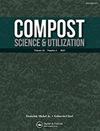Effect of Coffee Pulp Compost and P Fertilizer on Yield and Yield Components of Maize (Zea mays L.) in Gedeo Zone, Southern Ethiopia
IF 0.9
4区 农林科学
Q3 ECOLOGY
引用次数: 0
Abstract
Abstract Agricultural waste utilization in the form of compost is a sustainable alternative to fertilizer for increasing crop yield in smallholder farms. A study was conducted to investigate the effect of coffee pulp (CP) compost, phosphorus (P) fertilizer, and their combination on yield and yield components of maize in the Gedeo Zone, Southern Ethiopia, under rainfed conditions using maize variety BH140 as a test crop. The treatments consisted of four CP compost levels (0, 2.5, 5 and 7.5 t/ha) and four P levels (0, 10, 20 and 30 kg/ha) laid out in a factorial arrangement using a randomized complete block design with three replications. The analysis of variance revealed that there were significant (p ≤ 0.05) differences among the different levels of CP compost on tasseling date, ear length, 1000 seed weight, grain yield, biomass production, and harvest index of maize. P application had also a significant (p ≤ 0.05) effect on all measured yield components and final grain yield. Sole application of CP at the rate of 2.5 t/ha increased maize grain yield by 19% compared to control plots. Integration of CP compost at the rate of 2.5 t/ha with 30 and 20 kg P/ha increased maize grain yields by 63 and 60.85% compared to control plots, respectively. Thus, the integration of compost at the rate of 2.5 t/ha with 20 kg P/ha could be recommended for maximum grain yield. Farmers who cannot afford fertilizer would be encouraged to use CP compost at the rate of 2.5 t/ha.咖啡浆堆肥和磷肥对埃塞俄比亚南部Gedeo地区玉米产量及产量组成的影响
摘要在小农农场,以堆肥的形式利用农业废弃物是一种可持续的肥料替代品,可以提高作物产量。在埃塞俄比亚南部Gedeo地区,以玉米品种BH140为试验作物,研究了咖啡浆(CP)堆肥、磷(P)肥及其组合对雨养条件下玉米产量和产量组成的影响。4个CP堆肥水平(0、2.5、5和7.5 t/ha)和4个P水平(0、10、20和30 kg/ha),采用随机完全区组设计,按因子排列,3个重复。方差分析表明,不同水平CP堆肥对玉米抽雄期、穗长、千粒重、籽粒产量、生物量产量和收获指数的影响均显著(p≤0.05)。施磷量对籽粒产量各组成部分及最终产量均有显著影响(P≤0.05)。单施有机磷2.5 t/公顷,玉米产量比对照提高19%。按2.5 t/ hm2施用有机磷堆肥30和20 kg P/ hm2,玉米产量分别比对照提高63%和60.85%。因此,建议以2.5 t/ hm2 + 20 kg P/ hm2的堆肥用量组合可获得最大产量。负担不起肥料的农民将被鼓励以每公顷2.5吨的速度使用CP堆肥。
本文章由计算机程序翻译,如有差异,请以英文原文为准。
求助全文
约1分钟内获得全文
求助全文
来源期刊

Compost Science & Utilization
农林科学-生态学
CiteScore
4.10
自引率
0.00%
发文量
0
审稿时长
>36 weeks
期刊介绍:
4 issues per year
Compost Science & Utilization is currently abstracted/indexed in: CABI Agriculture & Environment Abstracts, CSA Biotechnology and Environmental Engineering Abstracts, EBSCOhost Abstracts, Elsevier Compendex and GEOBASE Abstracts, PubMed, ProQuest Science Abstracts, and Thomson Reuters Biological Abstracts and Science Citation Index
 求助内容:
求助内容: 应助结果提醒方式:
应助结果提醒方式:


